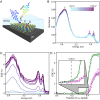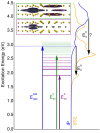Hot carrier extraction from 2D semiconductor photoelectrodes
- PMID: 37011201
- PMCID: PMC10104502
- DOI: 10.1073/pnas.2220333120
Hot carrier extraction from 2D semiconductor photoelectrodes
Abstract
Hot carrier-based energy conversion systems could double the efficiency of conventional solar energy technology or drive photochemical reactions that would not be possible using fully thermalized, "cool" carriers, but current strategies require expensive multijunction architectures. Using an unprecedented combination of photoelectrochemical and in situ transient absorption spectroscopy measurements, we demonstrate ultrafast (<50 fs) hot exciton and free carrier extraction under applied bias in a proof-of-concept photoelectrochemical solar cell made from earth-abundant and potentially inexpensive monolayer (ML) MoS2. Our approach facilitates ultrathin 7 Å charge transport distances over 1 cm2 areas by intimately coupling ML-MoS2 to an electron-selective solid contact and a hole-selective electrolyte contact. Our theoretical investigations of the spatial distribution of exciton states suggest greater electronic coupling between hot exciton states located on peripheral S atoms and neighboring contacts likely facilitates ultrafast charge transfer. Our work delineates future two-dimensional (2D) semiconductor design strategies for practical implementation in ultrathin photovoltaic and solar fuel applications.
Keywords: 2D materials; hot carrier; photoelectrochemistry; solar energy conversion; transient absorption spectroscopy.
Conflict of interest statement
The authors declare no competing interest.
Figures




References
-
- Nozik A. J., Spectroscopy and hot electron relaxation dynamics in semiconductor quantum wells and quantum dots. Annu. Rev. Phys. Chem. 52, 193–231 (2001). - PubMed
-
- Shockley W., Queisser H. J., Detailed balance limit of efficiency of p-n junction solar cells. J. Appl. Phys. 32, 510–519 (1961).
-
- Nozik A. J., Utilizing hot electrons. Nat. Energy 3, 170–171 (2018).
-
- Cooper G., Turner J. A., Parkinson B. A., Nozik A. J., Hot carrier injection of photogenerated electrons at indium phosphide-electrolyte interfaces. J. Appl. Phys. 54, 6463–6473 (1983).
-
- Nguyen D. T., et al. , Quantitative experimental assessment of hot carrier-enhanced solar cells at room temperature. Nat. Energy 3, 236–242 (2018).
Grants and funding
LinkOut - more resources
Full Text Sources

